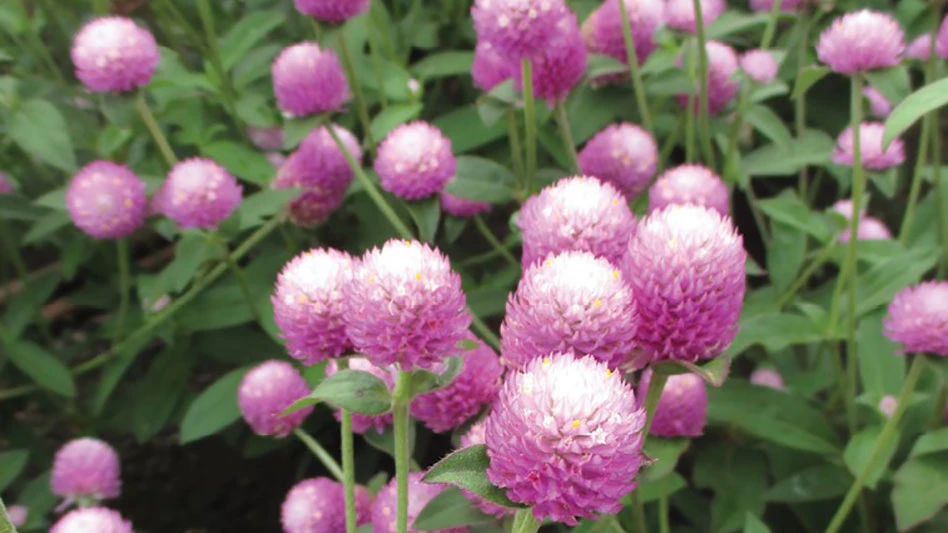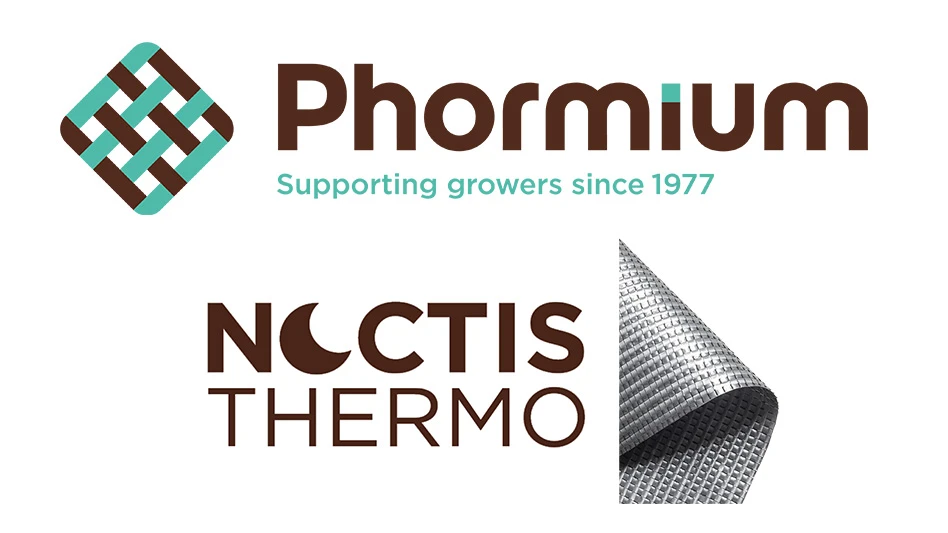

I’ve grown a wide selection of globe amaranths (Gomphrena sp.) over the last three decades. When in full bloom, they sure create a ruckus of interest in every instance. I’ve become acclimated to questions about those “colorful gumball-like” flowers and it’s no longer difficult to deduce what folks are describing out in the garden bed, border or container — all appropriate uses for this heat- and drought-tolerant annual. These popular, warm season annuals were introduced to Europe in the early 1700s and have been growing domestically since the 1730s. Recent breeding efforts in the last 30 years have yielded many amazing selections of this old-fashioned annual for the full sun garden.
Gomphrena is a genus of 90 species of mostly annuals and the majority of our domestic selections derive from two species (G. globosa and G. haageana). However, there are some other interesting species and hybrids that are becoming more readily available. Globe amaranth (G. globosa) is native to Central America and regions of Panama, Brazil and Guatemala. The Rio Grande globe amaranth (G. haageana) is native to New Mexico, Texas and Mexico. I’m surprised that more garden centers and nurseries don’t sell the amazingly wide selection of Gomphrena sp. (both seed and vegetative). Admittedly, seed germination is frustratingly low and while bedding gomphrenas are rarely in bloom to entice the spring customer, the floriferous results in the warmer portion of the growing season are memorable and noteworthy. Seeds (soaked in warm water for a day and sown heavily) should be started six to eight weeks before the last frost date and germinate at 70-75° F. With few insect problems and some resistance to rabbits and deer (I’ve observed sustained browsing on foliage/stems), globe amaranths may occasionally experience mildew and leaf spot issues, especially in areas of poor air circulation.
A member of the Amaranthaceae family, globe amaranths feature rounded, pompom-like blooms that are also frequently described as “clover-like.” The flower heads, traditionally shades of purple, magenta, pink, lavender, red, orange and white, are actually made up of colorful, showy, papery bracts with the “true” flowers barely perceptible and peeking out between these layers. The tiny, tubular, true flowers, typically white or yellow, are a magnet for both bees and butterflies. Globe amaranths flower all summer long until hard frost. Some varieties are termed “bicolor” which refers to a whiter top portion of the bracts above the primary color. Removing spent flowers, while not required, can result in more branching and a quicker flush of blooms. Taller varieties can be pinched back when they reach 6 inches in height for more branching and heavier flowering.
_dwyer_fmt.png)

In the landscape (and the vase)
Stiff, jointed, branched stems feature opposite, elliptical, narrow foliage. The foliage is typically presented in neutral shades of green. However, the variety ‘Cosmic Flare’ features golden-chartreuse foliage (bright pink flowers) and the new ‘Piñata’ has a subtle variegation (fuchsia-pink flowers). The leaves (edible) of globe amaranth have a long, local history with use in teas for anti-inflammatory properties and as a source of nutrients and antioxidants. This plant is entirely safe for pets and children.
Drought-tolerant once established, globe amaranths are not choosy about soil but do need good drainage. Full sun is ideal for all globe amaranths as they will stretch and be less floriferous in part shade. Extra watering during prolonged dry spells is warranted although avoid overhead watering when possible and water at the soil line to minimize potential fungal issues. These annuals are very light feeders in terms of fertilization. Too much fertilization or overly rich soils will result in more foliage and less flowering.
In terms of design use, globe amaranths are indispensable in just about any sunny situation as they offer “pinpoints of color” with colorful floating spheres. Aside from determining your “color of interest” with each variety, do research to determine the mature heights in flower as there are selections like ‘Fireworks’ which can get up to 48 inches tall and both the popular Gnome and Buddy series top out under 10 inches in flowering height. The gamut of “shin to chest” height in bloom offers a welcome diversity of statures for consideration. While shorter selections can augment the edge of a path or container, the taller selections can weave amongst “supportive neighbors” and offer pops of color throughout any landscape composition.
_fmt.png)




The rounded flower architecture of globe amaranth, contributed by those stiff, papery bracts, augments compositions with other flower forms like daisies, trumpets and spires and when combined in compositions with colorful foliage, globe amaranths are a noticeable asset. Used in mixed borders to fill in gaps for quick color, globe amaranths are excellent as scattered specimens, in larger groupings or certainly in the cutflower garden. In containers, globe amaranths can offer that supportive “hovering color” and the selections ‘Pink Zazzle’ and ‘Cabrillo’ are destined for increasing popularity as components in larger, sunny container settings.
Globe amaranths are common in fresh arrangements — they have a two-week vase life — and hold color when dried appropriately. To successfully dry globe amaranth, harvest blooms on long stems when fully opened, strip leaves and tie into bunches of 8-10 stems. Hang these bunches upside down in a well-ventilated location out of full sun for 2-3 weeks for the best drying success. Dried globe amaranth blooms have long been utilized in Hawaii for leis and in Nepal for ceremonial garlands.
More choices
My favorite globe amaranth is ‘Strawberry Fields’ (G. haageana). I think I’ve grown this mid-height (24 inches) variety every year for the past 30 years. It’s hard to find in retail, but seed offerings for this popular variety exist and this selection offers intense floating red spheres in the landscape. This hot color contribution has limitless application throughout the landscape.
The QIS Series also offers some excellent mid-height selections including ‘QIS Carmine’ which all but glows in the landscape.
The varieties ‘Forest Pink’ and ‘Lavender Lady’ have a proven track record of success and more common availability. ‘Fireworks’ and ‘Truffula Pink’ seem to be on a well-deserved popularity tour for stature, bright pink blooms and solid performance. As mentioned above, ‘Fireworks’ is the “loftiest” of the globe amaranths at 48 inches in height. The aptly named Pinball Series (white and purple) and Ping Pong Series (lavender, purple, white) are solid performers and all top out under 20” in height. The Las Vegas Series (pink, purple, white) is excellent for cutting and a uniform height of 18” in bloom. The best orange selection to look for is ‘QIS Orange’ (syn. ‘Woodcreek Orange’).
Globe amaranth (Gomphrena sp.), with such a long history of garden popularity and success, should be more readily available to gardeners. Exposure to the amazing diversity of use for this tough annual will continue to bring excitement and focus to maximize the full potential and range of these gorgeous gomphrenas.

Explore the September 2023 Issue
Check out more from this issue and find your next story to read.
Latest from Greenhouse Management
- This month's Greenhouse Management magazine is about native plants and sustainability
- The HC Companies, Classic Home & Garden merge as Growscape
- Terra Nova releases new echinacea variety, 'Fringe Festival'
- Eason Horticultural Resources will now officially be known as EHR
- BioWorks receives EPA approval for new biological insecticide for thrips, aphids, whiteflies
- ScottsMiracle-Gro transfers cannabis subsidiary to focus on core lawn and garden business
- Should we start calling natives 'eco-beneficial plants'?
- Ellen Mackenbach-Lakeman appointed new CEO of Dümmen Orange





